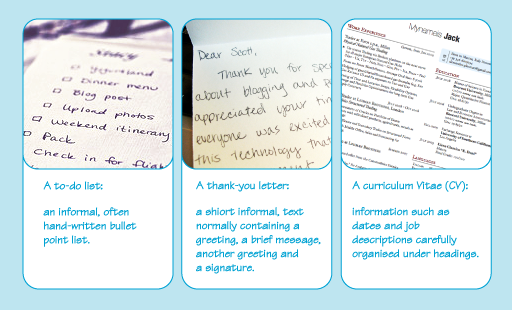1.1 Types and structure of everyday writing
When we write, we communicate with other people. Birthday cards, Post-it notes and text messages are all ways to send other people messages containing information. Even a personal diary and a to-do list may be read initially only by the writer, but may be shared or read in the future by other people.
Communication is therefore the main reason why people write. The particular purpose of each piece of writing depends on the situation and the people we communicate with. For example, many of us leave little notes on the fridge to remind ourselves and others to do important chores or to wish them well.
The way our texts are organised varies depending on our reason for writing and our relationship with the person or persons who will read our messages.
Activity _unit4.1.2 Activity 2
In this activity you will look at the purpose and structure of three texts (Figure 2).
Part 1
Look at the three texts below and match them to their typical purpose.
Two lists follow, match one item from the first with one item from the second. Each item can only be matched once. There are 3 items in each list.
-
A to-do list
-
A curriculum vitae (CV)
-
A thank-you card
Match each of the previous list items with an item from the following list:
a.To show an employer our skills and experiences in the hope of being invited to an interview
b.To briefly remind ourselves and others what needs to be done
c.To tell somebody how much we appreciate what they have done for us
- 1 = b,
- 2 = a,
- 3 = c
Part 2
Have you ever written any of these three types of text? How easy or difficult do you or would you find writing them? Note your thoughts in the box below before comparing them with mine.
Answer
Here is my answer:
I’m one of those people who often write to-do lists. They are simple and informal, and contain just isolated words describing activities. I normally cross off each activity as soon as it is done.
I find thank-you cards and cards in general less easy to write. This is in part because in Italy, my country, people tend to phone or thank other people in person so cards are rarely written. In the UK, handwritten cards tend to follow a specific structure but I am never sure which one I should use, in which order to different people in different situations. I therefore tend to avoid cards or buy ready-made cards and just add my signature.
A curriculum vitae is generally difficult to write. My first CV was untidy, quite long and contained too much information so I had to ask a more experienced friend to help me.
All texts, even the simplest everyday ones, are written for a purpose. When we write, we have this purpose and our readers in mind and this helps us to structure our texts.
Some texts are easy to write because we understand their purpose, they are part of our culture and we are familiar with their typical structure. However, approaching unfamiliar text types may be challenging unless we know why we are writing them and how they should be organised. In many cases a model of a particular type of text or a more experienced person can help.
The next sections introduce some texts you may not be familiar with. You will look at texts written by university students, the reasons why they are written and the ways in which they are organised.

